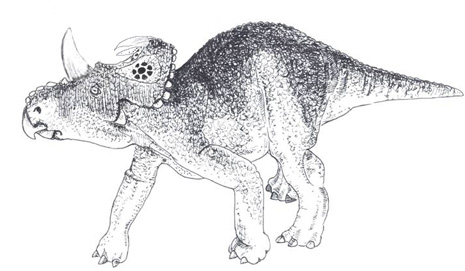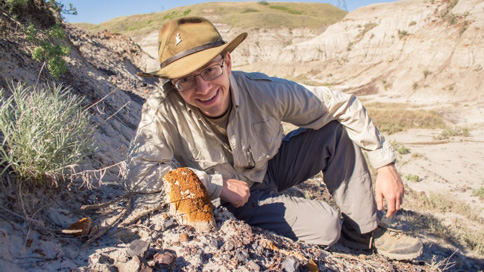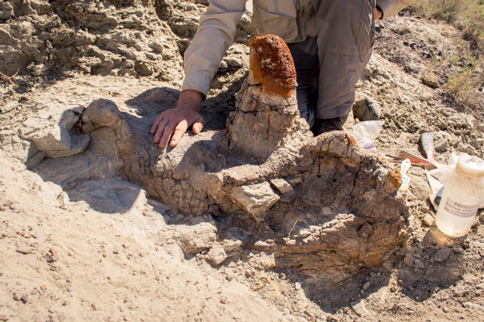A New Type of Horned Dinosaur Named “Hannah”
“Hannah” A New Species of Late Cretaceous Ceratopsian
PhD student Scott Persons (University of Alberta, Canada) is one of that admirable breed of young scientists, someone who simply exudes enthusiasm and passion for his work. In the summer of 2015, at a dig site just outside the Dinosaur Provincial Park, Scott spotted the large nasal horn of a dinosaur sticking out of the ground. The site the field team were exploring, had not been visited for decades, a couple of harsh Canadian winters would have reduced the nasal horn to frost shattered fragments but luckily Scott happened to spot the fossil and as a result a missing piece of the horned dinosaur family tree might get filled in.
A New Species of Ceratopsian
Finding a Dinosaur Fossil “Nose First”
Picture credit: Amanda Kelley
The matrix surrounding the horn corn was carefully removed and gradually more of the skull came into view. The remarkably near complete skull represents a new type of centrosaurine dinosaur, part of the horned dinosaur group. Once the skull had been prepared, then a helicopter was brought in to airlift the specimen out of the remote canyon in southern Alberta, where it had laid since that part of the world was a lush, tropical paradise that teemed with prehistoric life.
A Dinosaur Named after a Dog
Fans of the Flintstones cartoon programme may remember a pet dinosaur called “Dino” that behaved very like a dog. Well, thanks to Scott, things have gone full circle as he has nicknamed this new dinosaur “Hannah” after his own pet dog, that sometimes accompanies him on fossil digs. We are not sure what Hannah the dog will make of her namesake, let’s hope that she does not chew on any of the bones.
The Top Part of the Skull Nearly Excavated
Picture credit: Amanda Kelley
The picture above shows the skull of “Hannah”, Scott is resting his hand close to where the eye socket is, the snout of this pick-up truck sized dinosaur is facing to the right.
An Important Transitional Fossil
A field team from the University of Alberta have returned to the quarry site in a bid to recovery postcranial fossil material. The team are confident that a lot more of the skeleton remains embedded in the steeply sloping canyon side. Already, a number of bones have been excavated including a complete scapula (shoulder blade). The large nasal horn combined with evidence of forward projecting eppocipital elements from the top of the neck frill suggest that “Hannah” may possess a combination of traits leading scientists to tentatively propose that the specimen represents a transitional form from the older Centrosaurus genera to the younger and spectacular Styracosaurus.
Everything Dinosaur Attempts a Tentative Illustration of “Hannah”

Our interpretation of “Hannah” centrosaurine in nature with forward projecting epoccipital bones as part of the frill ornamentation.
Picture credit: Everything Dinosaur
Centrosaurus and Styracosaurus
Fossils of Centrosaurus, a dinosaur with a large nasal horn are found in older rocks, whilst fossils of the dinosaur known as Styracosaurus (another centrosaurine) are found in younger rocks.
Biostratigraphically, this new specimen comes in between these two and it may represent a transitional form, allowing palaeontologists to potentially, fill in a piece of the ceratopsian family tree. Much more work has to be done before “Hannah” can be scientifically described but this does represent a significant discovery.
For articulated models of ceratopsians such as Centrosaurus and Styracosaurus: Beasts of the Mesozoic Models.
As a PhD candidate, Scott is well used to field work but he describes this specimen as by far the most exciting thing he’s ever discovered.
He commented:
“I’m incredibly thrilled, but discovering it in the field, it’s a really slow burn.”
Although there is a lot of work at the quarry still to be done, for every hour spent in the field, another ten hours will be spent in the preparation laboratory, cleaning and examining the fossils.
Naming “Hannah” the Ceratopsian
It might be a while before “Hannah” has a binomial name, but it looks very likely that this will be a new genus of horned dinosaur, one of a plethora of centrosaurines and chasmosaurines known from the Late Cretaceous of North America.
Visit Everything Dinosaur’s website: Everything Dinosaur.



